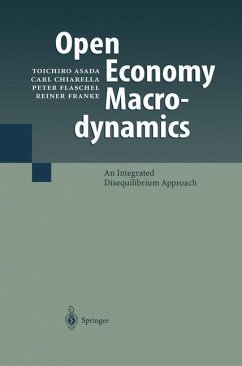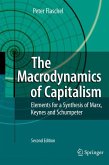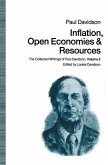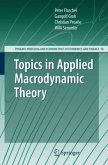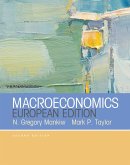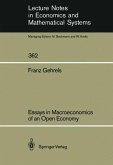Toichiro Asada, Carl Chiarella, Peter Flaschel
Open Economy Macrodynamics
An Integrated Disequilibrium Approach
Toichiro Asada, Carl Chiarella, Peter Flaschel
Open Economy Macrodynamics
An Integrated Disequilibrium Approach
- Broschiertes Buch
- Merkliste
- Auf die Merkliste
- Bewerten Bewerten
- Teilen
- Produkt teilen
- Produkterinnerung
- Produkterinnerung
In the first part of this book, we treat interacting and small open economies. We do this from an historical perspective, starting from the Classical model of the gold standard and the specie-flow mechanism and aim to show there that the Dornbusch IS-LM-PC approach, with or without rational expectations, can still be considered as a (if not the) core contribution to contemporaneous open economy macrodynamics, also on the level of structural macroeconometric model building. In the second part we then extend this analysis to the incorporation of more disequilibrium on the real markets, prominent…mehr
Andere Kunden interessierten sich auch für
![The Macrodynamics of Capitalism The Macrodynamics of Capitalism]() Peter FlaschelThe Macrodynamics of Capitalism116,99 €
Peter FlaschelThe Macrodynamics of Capitalism116,99 €![The New Generation of Computable General Equilibrium Models The New Generation of Computable General Equilibrium Models]() The New Generation of Computable General Equilibrium Models132,99 €
The New Generation of Computable General Equilibrium Models132,99 €![Inflation, Open Economies and Resources Inflation, Open Economies and Resources]() Inflation, Open Economies and Resources60,99 €
Inflation, Open Economies and Resources60,99 €![Topics in Applied Macrodynamic Theory Topics in Applied Macrodynamic Theory]() Peter FlaschelTopics in Applied Macrodynamic Theory110,99 €
Peter FlaschelTopics in Applied Macrodynamic Theory110,99 €![Macroeconomics (European Edition) Macroeconomics (European Edition)]() Mark TaylorMacroeconomics (European Edition)75,99 €
Mark TaylorMacroeconomics (European Edition)75,99 €![Essays in Macroeconomics of an Open Economy Essays in Macroeconomics of an Open Economy]() Franz GehrelsEssays in Macroeconomics of an Open Economy39,99 €
Franz GehrelsEssays in Macroeconomics of an Open Economy39,99 €![The Open Economy Macromodel: Past, Present and Future The Open Economy Macromodel: Past, Present and Future]() Arie Arnon / Warren Young (eds.)The Open Economy Macromodel: Past, Present and Future77,99 €
Arie Arnon / Warren Young (eds.)The Open Economy Macromodel: Past, Present and Future77,99 €-
-
-
In the first part of this book, we treat interacting and small open economies. We do this from an historical perspective, starting from the Classical model of the gold standard and the specie-flow mechanism and aim to show there that the Dornbusch IS-LM-PC approach, with or without rational expectations, can still be considered as a (if not the) core contribution to contemporaneous open economy macrodynamics, also on the level of structural macroeconometric model building. In the second part we then extend this analysis to the incorporation of more disequilibrium on the real markets, prominent further feedback channels of the macrodynamic literature and integrated macromodel building. We start from the closed economy, consider large open economies in a fixed exchange rate system, small open economies subject to high capital mobility, and finally two large interacting economies like the USA and Euroland. Our macrofounded approach extends and integrates non-market clearing traditions to macrodynamics and can be usefully compared with the New Keynesian approaches which are generally rigorously microfounded, but often much more limited in scope in capturing full market and agent interactions.
Produktdetails
- Produktdetails
- Verlag: Springer / Springer Berlin Heidelberg / Springer, Berlin
- Artikelnr. des Verlages: 978-3-642-07274-1
- Softcover reprint of hardcover 1st ed. 2003
- Seitenzahl: 560
- Erscheinungstermin: 6. Dezember 2010
- Englisch
- Abmessung: 235mm x 155mm x 30mm
- Gewicht: 838g
- ISBN-13: 9783642072741
- ISBN-10: 3642072747
- Artikelnr.: 32072049
- Verlag: Springer / Springer Berlin Heidelberg / Springer, Berlin
- Artikelnr. des Verlages: 978-3-642-07274-1
- Softcover reprint of hardcover 1st ed. 2003
- Seitenzahl: 560
- Erscheinungstermin: 6. Dezember 2010
- Englisch
- Abmessung: 235mm x 155mm x 30mm
- Gewicht: 838g
- ISBN-13: 9783642072741
- ISBN-10: 3642072747
- Artikelnr.: 32072049
1 The Closed Economy: The Frisch or Keynes Paradigm?.- 1.1 Introduction.- 1.2 Neoclassical macrodynamics: Supply-side inflation inertia and self-correcting unemployment dynamics.- 1.3 Keynesian macrodynamics: Textbook stagflation theory and beyond.- 1.3.1 Introduction.- 1.3.2 Medium-run IS-LM analysis?.- 1.3.3 IS-LM-PC analysis proper.- 1.3.4 Local stability properties.- 1.3.5 Global analysis I: Floors and ceilings?.- 1.3.6 Global analysis II: A kinked money wage Phillips curve.- 1.4 Conclusions and outlook.- 1.5 Reading list.- 1.6 Appendix: Keynes' notes on the trade cycle.- I Open Economy Macrodynamics in Historical Perspective.- 2 Classical Two-Country Dynamics: Pure Price Adjustments?.- 2.1 Trade under the gold standard.- 2.2 Trade, specie flows and purchasing power parity.- 2.3 A one-good monetary model of international commodity trade.- 2.4 The monetary adjustment process.- 2.5 Currency devaluation: Short-, medium- and long-run effects.- 2.6 The two-commodity extension.- 2.7 The pure monetary model: Basic and advanced formulations.- 2.8 Unemployment in the Classical trade model.- 2.9 Conclusions.- 2.10 Reading list.- 2.11 Notation.- 2.12 Appendix: The Classical version of the Keynesian income-expenditure model.- 3 Keynesian Two-Country Dynamics: Pure Quantity Adjustments.- 3.1 Bretton Woods, Phase I: The renewed evolution of international trade.- 3.2 The Keynesian approach to international trade.- 3.3 The two-country dynamic multiplier model.- 3.4 Currency devaluation in the multiplier model.- 3.5 Metzlerian inventory dynamics in the symmetric two-country case.- 3.6 Conclusions.- 3.7 Reading list.- 3.8 Notation.- 3.9 Appendix: The Keynesian version of the income-expenditure model.- 4 Output, Interest and Changing Exchange Rate Regimes.- 4.1 Bretton Woods Phase II: Trade and increasing capital mobility.- 4.2 The textbook Mundell-Fleming model.- 4.3 Monetary policy.- 4.4 Fiscal policy.- 4.5 Two-country Mundell-Fleming models: Basic aspects and extensions.- 4.6 Conclusions.- 4.7 Reading list.- 4.8 Notation.- 4.9 Appendix: The Mundell-Fleming-Tobin approach to small open economies.- 5 Exchange Rate Volatility.- 5.1 Capital mobility, flexible exchange rates and the role of expectations.- 5.2 Exchange rate dynamics in the IS-LM-PC model: Level-form analysis.- 5.2.1 The model and its stationary state.- 5.2.2 Comparative static analysis.- 5.2.3 Graphical representation and fundamental implications.- 5.3 Exchange rate dynamics in the IS-LM-PC model: Loglinear analysis.- 5.3.1 Loglinear representation and analysis.- 5.3.2 Myopic perfect foresight and learning.- 5.3.3 Imperfect capital mobility.- 5.4 Rational expectations IS-LM-PC dynamics.- 5.4.1 The case of the small open economy.- 5.4.2 A symmetric two-country analysis.- 5.4.3 A critique of the 'rational expectations' methodology.- 5.5 Exchange rate dynamics in the Dornbusch model: The most basic case.- 5.6 Conclusions.- 5.7 Reading list.- 5.8 Notation.- 5.9 Appendix: A Keynes-Wicksell reformulation of exchange rate dynamics.- II Keynes-Metzler-Goodwin Dynamics in Open Economies.- 6 KMG Model Building: The Baseline Case of a 'Closed' US-Economy.- 6.1 Introduction.- 6.2 Reformulating Keynesian AS-AD Macrodynamics.- 6.2.1 The 3D Rose type wage-price dynamics.- 6.2.2 The 2D Metzlerian quantity dynamics and capital stock growth.- 6.2.3 Putting things together: The KMG growth dynamics.- 6.2.4 Feedback-motivated stability analysis.- 6.3 Monetary Policy in KMG Growth Dynamics.- 6.3.1 Introducing monetary policy rules.- 6.3.2 The dynamics with estimated parameters.- 6.3.3 Kinked money wage Phillips Curves.- 6.3.4 The role of monetary policy rules reconsidered.- 6.4 Conclusions.- 6.5 Appendices.- 6.5.1 Appendix 1: The KMG dynamics in extensive form.- 6.5.2 Appendix 2: Detailed proof of theorem 6.1.- 7 Large Open KMG Economies: Germany within the EMU.- 7.1 Introduction.- 7.2 The model in extensive form.- 7.3 Intensive form and steady state analysis.- 7.4 Feedback motivated stability analysis.- 7.5 Monetary policy rules to fight inflation in the dominant country.- 7.6 Conclusions and Outlook.- 8 Small Open KMG Economies: Australia and the Murphy model.- 8.1 Introduction.- 8.2 The small open economy: The model.- 8.3 The core 8D dynamics: Assumptions and intensive form.- 8.4 The five feedback mechanisms of the model.- 8.5 Steady state and stability propositions.- 8.6 Rigorous 8D stability proof.- 8.7 Numerical simulations of the dynamics.- 8.7.1 Numerical simulations of the 8D dynamics.- 8.7.2 Adding sluggish trade balance adjustments.- 8.7.3 The kinked money-wage Phillips Curve reconsidered.- 8.7.4 Period-doubling routes to chaos.- 8.8 Conclusions.- 8.9 Appendix 1: The KWG simplification of the KMG approach.- 8.10 Appendix 2: Rigorous stability proof for the KWG case.- 9 Global Stability: Subsystem Approaches.- 9.1 Introduction.- 9.2 Dornbusch type exchange rate subdynamics.- 9.3 Metzlerian output-inventory interaction.- 9.4 The Tobin real-interest-rate inflation dynamics.- 9.5 The Rose real-wage feedback channel.- 9.6 Outlook: 3D and 4D extensions of the 2D cases.- 10 Two-Country Business Cycle Models: 'Euroland and the USA'.- 10.1 Introduction.- 10.2 Two interacting KWG economies.- 10.3 The core 10D KWG growth dynamics.- 10.4 Steady state and ?-stability analysis: Overview.- 10.5 Rigorous 10D stability proof.- 10.6 Numerical investigation of the KWG dynamics.- 10.7 Outlook: From 10D KWG to 14D KMG growth and beyond.- 10.8 Appendix to section 10.5.- Mathematical Appendix: Some useful theorems.- Notation (for part II).- References.
1 The Closed Economy: The Frisch or Keynes Paradigm?.- 1.1 Introduction.- 1.2 Neoclassical macrodynamics: Supply-side inflation inertia and self-correcting unemployment dynamics.- 1.3 Keynesian macrodynamics: Textbook stagflation theory and beyond.- 1.3.1 Introduction.- 1.3.2 Medium-run IS-LM analysis?.- 1.3.3 IS-LM-PC analysis proper.- 1.3.4 Local stability properties.- 1.3.5 Global analysis I: Floors and ceilings?.- 1.3.6 Global analysis II: A kinked money wage Phillips curve.- 1.4 Conclusions and outlook.- 1.5 Reading list.- 1.6 Appendix: Keynes' notes on the trade cycle.- I Open Economy Macrodynamics in Historical Perspective.- 2 Classical Two-Country Dynamics: Pure Price Adjustments?.- 2.1 Trade under the gold standard.- 2.2 Trade, specie flows and purchasing power parity.- 2.3 A one-good monetary model of international commodity trade.- 2.4 The monetary adjustment process.- 2.5 Currency devaluation: Short-, medium- and long-run effects.- 2.6 The two-commodity extension.- 2.7 The pure monetary model: Basic and advanced formulations.- 2.8 Unemployment in the Classical trade model.- 2.9 Conclusions.- 2.10 Reading list.- 2.11 Notation.- 2.12 Appendix: The Classical version of the Keynesian income-expenditure model.- 3 Keynesian Two-Country Dynamics: Pure Quantity Adjustments.- 3.1 Bretton Woods, Phase I: The renewed evolution of international trade.- 3.2 The Keynesian approach to international trade.- 3.3 The two-country dynamic multiplier model.- 3.4 Currency devaluation in the multiplier model.- 3.5 Metzlerian inventory dynamics in the symmetric two-country case.- 3.6 Conclusions.- 3.7 Reading list.- 3.8 Notation.- 3.9 Appendix: The Keynesian version of the income-expenditure model.- 4 Output, Interest and Changing Exchange Rate Regimes.- 4.1 Bretton Woods Phase II: Trade and increasing capital mobility.- 4.2 The textbook Mundell-Fleming model.- 4.3 Monetary policy.- 4.4 Fiscal policy.- 4.5 Two-country Mundell-Fleming models: Basic aspects and extensions.- 4.6 Conclusions.- 4.7 Reading list.- 4.8 Notation.- 4.9 Appendix: The Mundell-Fleming-Tobin approach to small open economies.- 5 Exchange Rate Volatility.- 5.1 Capital mobility, flexible exchange rates and the role of expectations.- 5.2 Exchange rate dynamics in the IS-LM-PC model: Level-form analysis.- 5.2.1 The model and its stationary state.- 5.2.2 Comparative static analysis.- 5.2.3 Graphical representation and fundamental implications.- 5.3 Exchange rate dynamics in the IS-LM-PC model: Loglinear analysis.- 5.3.1 Loglinear representation and analysis.- 5.3.2 Myopic perfect foresight and learning.- 5.3.3 Imperfect capital mobility.- 5.4 Rational expectations IS-LM-PC dynamics.- 5.4.1 The case of the small open economy.- 5.4.2 A symmetric two-country analysis.- 5.4.3 A critique of the 'rational expectations' methodology.- 5.5 Exchange rate dynamics in the Dornbusch model: The most basic case.- 5.6 Conclusions.- 5.7 Reading list.- 5.8 Notation.- 5.9 Appendix: A Keynes-Wicksell reformulation of exchange rate dynamics.- II Keynes-Metzler-Goodwin Dynamics in Open Economies.- 6 KMG Model Building: The Baseline Case of a 'Closed' US-Economy.- 6.1 Introduction.- 6.2 Reformulating Keynesian AS-AD Macrodynamics.- 6.2.1 The 3D Rose type wage-price dynamics.- 6.2.2 The 2D Metzlerian quantity dynamics and capital stock growth.- 6.2.3 Putting things together: The KMG growth dynamics.- 6.2.4 Feedback-motivated stability analysis.- 6.3 Monetary Policy in KMG Growth Dynamics.- 6.3.1 Introducing monetary policy rules.- 6.3.2 The dynamics with estimated parameters.- 6.3.3 Kinked money wage Phillips Curves.- 6.3.4 The role of monetary policy rules reconsidered.- 6.4 Conclusions.- 6.5 Appendices.- 6.5.1 Appendix 1: The KMG dynamics in extensive form.- 6.5.2 Appendix 2: Detailed proof of theorem 6.1.- 7 Large Open KMG Economies: Germany within the EMU.- 7.1 Introduction.- 7.2 The model in extensive form.- 7.3 Intensive form and steady state analysis.- 7.4 Feedback motivated stability analysis.- 7.5 Monetary policy rules to fight inflation in the dominant country.- 7.6 Conclusions and Outlook.- 8 Small Open KMG Economies: Australia and the Murphy model.- 8.1 Introduction.- 8.2 The small open economy: The model.- 8.3 The core 8D dynamics: Assumptions and intensive form.- 8.4 The five feedback mechanisms of the model.- 8.5 Steady state and stability propositions.- 8.6 Rigorous 8D stability proof.- 8.7 Numerical simulations of the dynamics.- 8.7.1 Numerical simulations of the 8D dynamics.- 8.7.2 Adding sluggish trade balance adjustments.- 8.7.3 The kinked money-wage Phillips Curve reconsidered.- 8.7.4 Period-doubling routes to chaos.- 8.8 Conclusions.- 8.9 Appendix 1: The KWG simplification of the KMG approach.- 8.10 Appendix 2: Rigorous stability proof for the KWG case.- 9 Global Stability: Subsystem Approaches.- 9.1 Introduction.- 9.2 Dornbusch type exchange rate subdynamics.- 9.3 Metzlerian output-inventory interaction.- 9.4 The Tobin real-interest-rate inflation dynamics.- 9.5 The Rose real-wage feedback channel.- 9.6 Outlook: 3D and 4D extensions of the 2D cases.- 10 Two-Country Business Cycle Models: 'Euroland and the USA'.- 10.1 Introduction.- 10.2 Two interacting KWG economies.- 10.3 The core 10D KWG growth dynamics.- 10.4 Steady state and ?-stability analysis: Overview.- 10.5 Rigorous 10D stability proof.- 10.6 Numerical investigation of the KWG dynamics.- 10.7 Outlook: From 10D KWG to 14D KMG growth and beyond.- 10.8 Appendix to section 10.5.- Mathematical Appendix: Some useful theorems.- Notation (for part II).- References.

